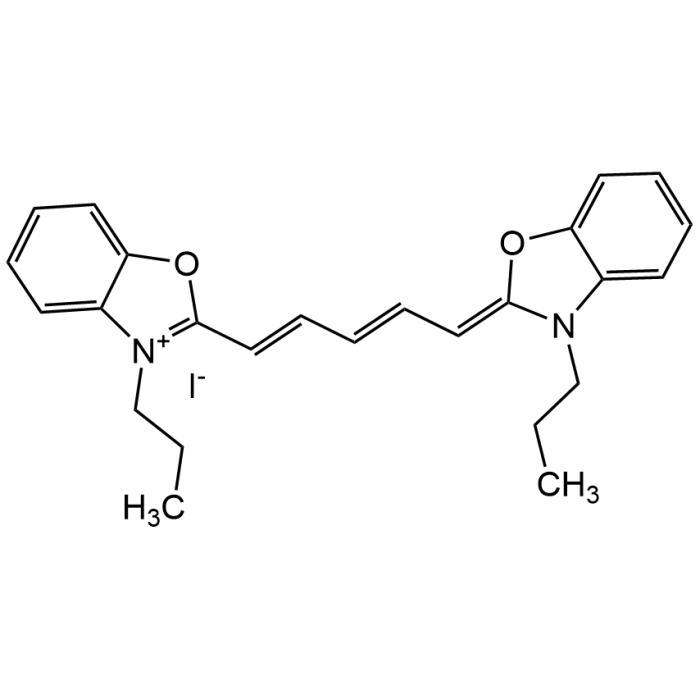Cookie Policy: This site uses cookies to improve your experience. You can find out more about our use of cookies in our Privacy Policy. By continuing to browse this site you agree to our use of cookies.
Chemodex
3,3'-Dipropyloxadicarbocyanine iodide
As low as
116
CHF
CHF 116.00
In stock
Only %1 left
CDX-D0438-M05050 mgCHF 116.00
CDX-D0438-M100100 mgCHF 200.00
CDX-D0438-M250250 mgCHF 400.00

| Product Details | |
|---|---|
| Synonyms | DiOC3(5); NK 2606; 3-Propyl-2-{(1E,3E)-5-[3-propyl-1,3-benzoxazol-2(3H)-ylidene]-1,3-pentadienyl}-1,3-benzoxazol-3-ium iodide |
| Product Type | Chemical |
| Properties | |
| Formula | C25H27IN2O2 |
| MW | 514.41 |
| CAS | 53213-90-4 |
| Source/Host Chemicals | Synthetic |
| Purity Chemicals | ≥97.5% (HPLC) |
| Appearance | Dark blue crystalline powder. |
| Solubility | Soluble in DMSO or ethanol. |
| Identity | Determined by 1H-NMR. |
| Declaration | Manufactured by Chemodex. |
| Other Product Data |
Click here for Original Manufacturer Product Datasheet |
| InChi Key | VILDQFLUZSBAGE-UHFFFAOYSA-M |
| Smiles | [I-].O1C=2C=CC=CC2N(C1=CC=CC=CC=3OC=4C=CC=CC4[N+]3CCC)CCC |
| Shipping and Handling | |
| Shipping | AMBIENT |
| Short Term Storage | +4°C |
| Long Term Storage | -20°C |
| Handling Advice |
Keep under inert gas. Protect from light and oxygen. |
| Use/Stability | Stable for at least 2 years after receipt when stored at -20°C. |
| Documents | |
| Product Specification Sheet | |
| Datasheet |
 Download PDF Download PDF |
Description
DiOC3(5) is a fluorescent carbocyanine dye used to measure mitochondrial or bacterial membrane potential or for nucleic acid staining, by binding to DNA and RNA. It can be used for flow cytometry and live cell microscopy. Carbocyanine dyes are unique organic molecules that contain a conjugated electron-deficient system between two heterocyclic nitrogen atoms that provides characteristically long absorption and emission wavelengths. Spectral Data: Excitation max: ~577nm, Emission max: ~595-640nm (accord. Lit). Intermediate for the synthesis of fluorescent probes.
Product References
(1) R.D. Philo & A.A Eddy; Biochem. J. 174, 801 (1978) | (2) E.G. Guillet & G.A. Kimmich; J. Membr. Biol. 59, 1 (1981) | (3) D.H. Wiegand & P. Vanysek; Appl. Spectrosc. 42, 958 (1988) | (4) M. Wang, et al.; JACS 122, 9977 (2000)





